Yesterday was the last day for regularly scheduled hours in the shop until March 1. I still come to work every day, but there is a change in the routine. I am on an internal, diurnal, noctural, natural, subdural, under the weather schedule. I am not looking out the window, I am looking in. I don’t plan much. I put my watch in the drawer. I eat potato chips whenever I feel like it. My mind wanders, and my hands are itching to make this, try that, hold whatever up to the light.
I have design projects needing some resolution by spring. All of them are in my mind; I like to let things cook before I put a pencil to paper. That cooking can take a long time; the long low heat makes for a tender stew with great flavor. Things surface in no particular order-fine. My reaction to the gardening season 2010 being in the distant future? Spring can wait. In December I am still working furiously; this spills over into early January. Long about January 5, I shift gears. No more daily lists. I sleep soundly and long. Were I a bear, I would Dylan Thomas my way resolutely into that good night. The seasonal life suits me perfectly. I like very very on, and very, very off; I am not a big fan of a daily drip.
My life changes during my late year streaming. Do you not admire this lingo coming from an old girl? It so amuses me. My concept of streaming is more stream of consciousness. You never know what might float by. January is time to give time to what surfaces, and see where it takes you. It is about taking direction from something that hasn’t crossed my mind yet. A new year is firstly about second chances, and more importantly, about the future. The future is our most precious treasure. As much as the present infuses my life with color, serious discourse, and energy, the future pushes me. My January is all about that future. Rob is shopping for Detroit Garden Works holiday and spring 2010 as I write. I have had 130 or so emails from him, loaded with photographs, in the past two days. January is a perfect time to take some ideas, and turn them into a collection for the shop. We talk plenty, seeds get sown , a plan gets buried in some good dirt-something good grows out of this. The winter lays me low; I am a growing girl, no question. I do the best I can to live good naturedly over the winter. Making topiary sculpture from natural materials, painting, designing new pots for Branch to build, repainting and rearranging the shop, reading, my spring design projects-I am terribly busy in an aimlessly good way. I need for nothing to be all put together right now.
At the intersection of Routine Street and Invention Boulevard, there is never any question which route I will take. Routine Street is at least 8 paved lanes wide, and goes on with nary a twist nor turn for what seems like a lifetime. This is not to say I am not influenced by the work of others-far from it. There are so many talented people out there whose work I truly respect and value. But January life is about turning what influences me inside out and upside down and running it down the block. If I am able to explain how, and with what materials, and why I have done what I have done, I will. I know I will be moving on to something else today. What I did yesterday does not completely define me. I would want to be a what will come next girl. I also believe that if a person can teach, they should. Transmit what they can. If people listen and try to reproduce my experiments, I am happy for this. As I think my eye and my sensibility is unique to me, no one could take that from me. I do meet people in various design fields who never seem to veer off what someone else has dreamed up-this is mostly about a lack of confidence, not a lack of imagination. Rarely there will be someone who deliberately claims the work of others as their own; I feel sorry for them. They have eliminated any possibility of satisfaction from their lives. How miserable a deed, and consequently, how miserable this must feel.
Invention Blvd is an uncharted and unmarked two track known for its hairpin turns, narrow bridges, wildlife in the road and predictably foggy weather. Does this not sound like the best fun? I have written this post in fits and starts over the past two days. That’s how things work for me, in January.
 en grisaille: to paint in a limited palette, light in value, and monochromatic-usually grey
en grisaille: to paint in a limited palette, light in value, and monochromatic-usually grey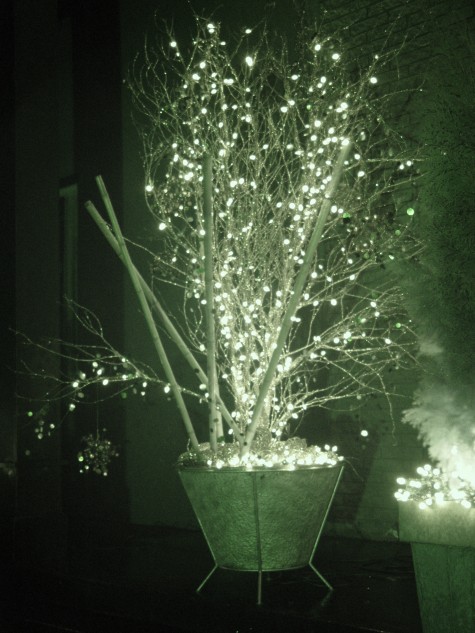

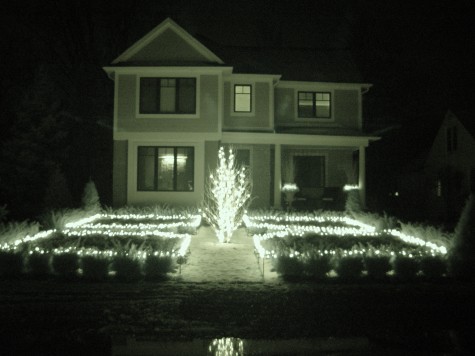
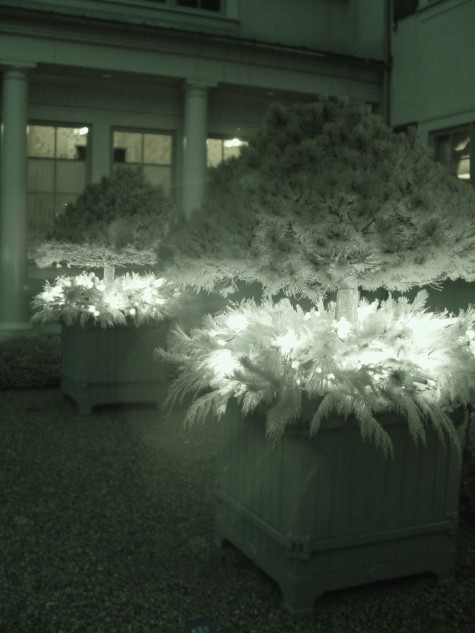


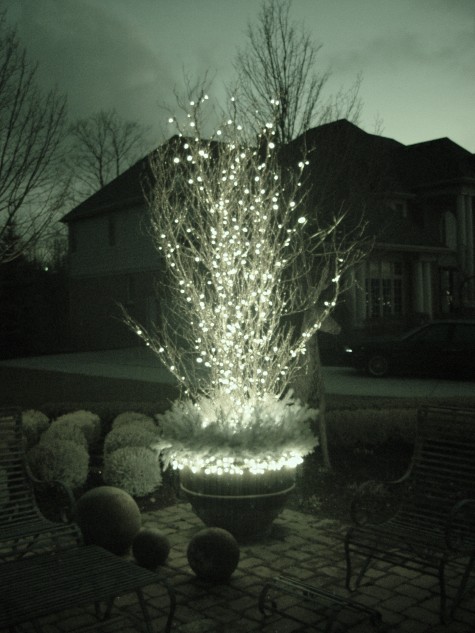


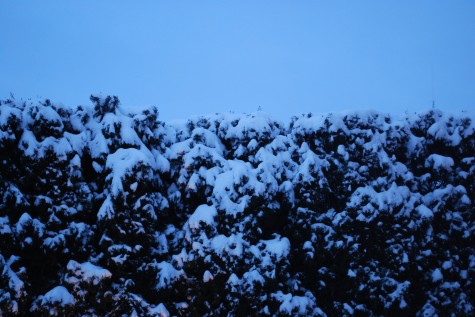 I have grown serviceable, if short lived stands of delphinium belladonna and bellamosa, but blue is brief in my garden; pansies, violas, lobelia, and phlox divaricata. My big blue garden season is the winter. The combination of snow, sky, and dark turns everything in the landscape blue.
I have grown serviceable, if short lived stands of delphinium belladonna and bellamosa, but blue is brief in my garden; pansies, violas, lobelia, and phlox divaricata. My big blue garden season is the winter. The combination of snow, sky, and dark turns everything in the landscape blue.  Our climate supports many evergreens whose green needles have a distinctively bluish cast. Frazier fir is a blue green color. The stately giant Concolor Fir is a pale blue grey. The color stands out such that I have never known how to place them in a landscape where they seemed beautiful, and not theatrical-except at a great distance from the eye.
Our climate supports many evergreens whose green needles have a distinctively bluish cast. Frazier fir is a blue green color. The stately giant Concolor Fir is a pale blue grey. The color stands out such that I have never known how to place them in a landscape where they seemed beautiful, and not theatrical-except at a great distance from the eye. 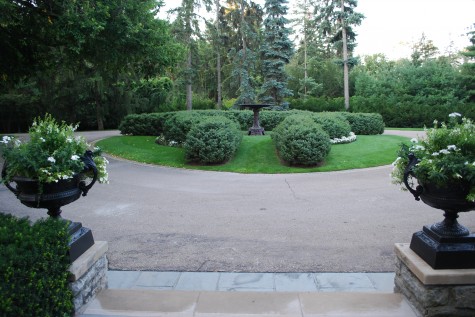 Blue spruce is a very popular evergreen to plant, though I have never done so. I find most properties I deal with are too small to carry that blue color convincingly. When I think blue in a landscape, I think about mountains, hazy with evergreens, very far away. These dwarf Serbian spruce are not quite as blue as the spruce in the background, but they quietly reference the color blue.
Blue spruce is a very popular evergreen to plant, though I have never done so. I find most properties I deal with are too small to carry that blue color convincingly. When I think blue in a landscape, I think about mountains, hazy with evergreens, very far away. These dwarf Serbian spruce are not quite as blue as the spruce in the background, but they quietly reference the color blue.  We have the blue of the sky and the water. Michigan is home to the great, the medium, and the small lakes-all of them beautiful. Years ago I never thought about water in a garden; I would not do without the color and the sound of water now.
We have the blue of the sky and the water. Michigan is home to the great, the medium, and the small lakes-all of them beautiful. Years ago I never thought about water in a garden; I would not do without the color and the sound of water now.  I grow lots of plants that are blue green. Rosemary, curly liriope, and variegated licorice-my favorite combination this past summer. Planted in an English lead pot, set on a bluestone terrace-a modest celebration of blue.
I grow lots of plants that are blue green. Rosemary, curly liriope, and variegated licorice-my favorite combination this past summer. Planted in an English lead pot, set on a bluestone terrace-a modest celebration of blue. I do have clients who like their swimming pools Florida blue. Fine. She had such a thing for that blue, we painted the inserts in her steel boxes blue, to match the frames on her windows. This may not appeal to everyone, but it doesn’t need to. I like seeing people pursue what makes them happy.
I do have clients who like their swimming pools Florida blue. Fine. She had such a thing for that blue, we painted the inserts in her steel boxes blue, to match the frames on her windows. This may not appeal to everyone, but it doesn’t need to. I like seeing people pursue what makes them happy. 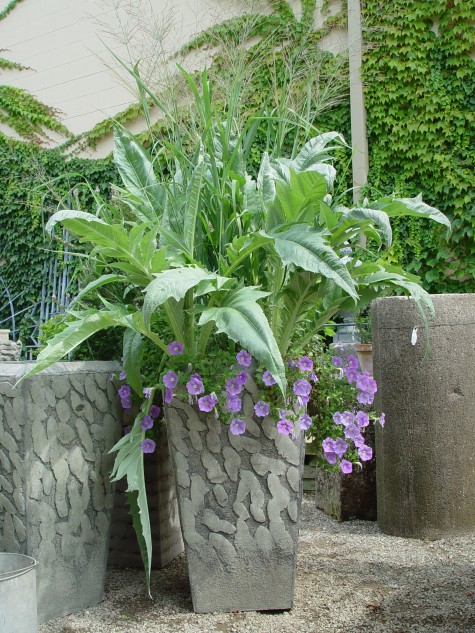 Silver foliaged plants are a good source of blue. This cardoon makes subtle reference to blue-as do lamb’s ears, achillea Moonshine, thyme lanuginosus, silver plectranthus, and so on. Any number of non-hardy succulents make a bigger visual deal of blue-if drop dead blue pleases you.
Silver foliaged plants are a good source of blue. This cardoon makes subtle reference to blue-as do lamb’s ears, achillea Moonshine, thyme lanuginosus, silver plectranthus, and so on. Any number of non-hardy succulents make a bigger visual deal of blue-if drop dead blue pleases you. 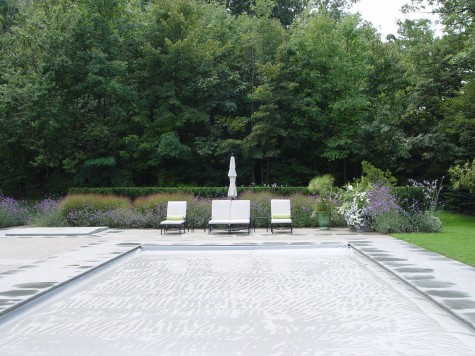 Our natural blues are those moody grey blues. This color is easy to work with. White is great. Red is striking. Pink is sweet. Green is a natural. Yellow is friendly and outgoing. Lime green is cool and sophisticated. Orange and blue attract attention. You get the idea.
Our natural blues are those moody grey blues. This color is easy to work with. White is great. Red is striking. Pink is sweet. Green is a natural. Yellow is friendly and outgoing. Lime green is cool and sophisticated. Orange and blue attract attention. You get the idea.
 A mass of red tulips in the spring is enough to get any gardener’s juices flowing again. That red is as densely saturated as a brand new lipstick. Lit from the front, these red tulips read vibrantly for another important reason-their companion color is green. The primary color red, and the secondary color green, are opposite each other on the color wheel. This opposition translates as maximum contrast. Red will never seem redder than when it is viewed next to green. Black/red and lime green-a great color combination.
A mass of red tulips in the spring is enough to get any gardener’s juices flowing again. That red is as densely saturated as a brand new lipstick. Lit from the front, these red tulips read vibrantly for another important reason-their companion color is green. The primary color red, and the secondary color green, are opposite each other on the color wheel. This opposition translates as maximum contrast. Red will never seem redder than when it is viewed next to green. Black/red and lime green-a great color combination.
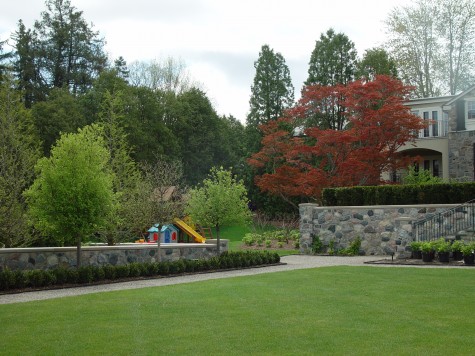 Not that muddy can’t be pleasing; the subdued red leaves of this very old Japanese maple make for an interesting variation in this landscape. The red is mixing and relating to other greens in the landscape in a subtle, not a jarring way. What is it about a dwarf red Japanese maple that makes it de rigueur in so many suburban landscapes? If it is the red color, then I see many plantings that do not present that red in a striking or thoughtful way.
Not that muddy can’t be pleasing; the subdued red leaves of this very old Japanese maple make for an interesting variation in this landscape. The red is mixing and relating to other greens in the landscape in a subtle, not a jarring way. What is it about a dwarf red Japanese maple that makes it de rigueur in so many suburban landscapes? If it is the red color, then I see many plantings that do not present that red in a striking or thoughtful way. 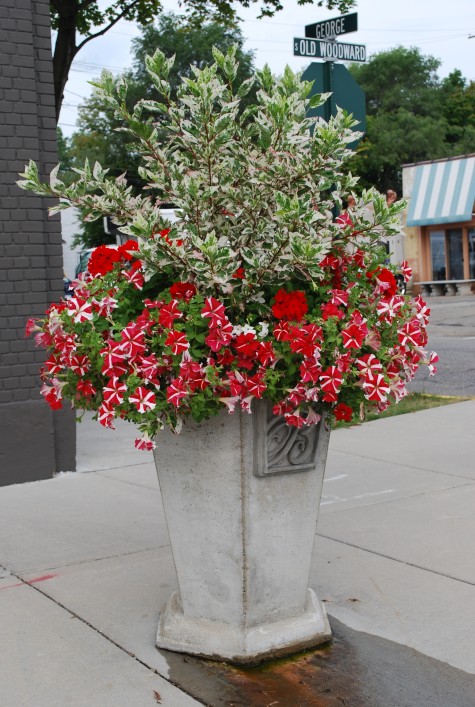 How red reads gets a big boost from white, or gray. Pale companionship or background helps red to hold its own. This green and white variegated hibiscus is grown primarily for its foliage. I used it as a centerpiece in this pot primarily to showcase the red. A thriving planting of petunias is much more about the flowers than the foliage-not much petunia foliage showing here. The white variegation on the hibiscus similarly reduces the amount of green. The red color is the star of the show. A red Japanese maple underplanted with Lamium “White Nancy”, or a dwarf low white variegated hosta might benefit in a likewise way.
How red reads gets a big boost from white, or gray. Pale companionship or background helps red to hold its own. This green and white variegated hibiscus is grown primarily for its foliage. I used it as a centerpiece in this pot primarily to showcase the red. A thriving planting of petunias is much more about the flowers than the foliage-not much petunia foliage showing here. The white variegation on the hibiscus similarly reduces the amount of green. The red color is the star of the show. A red Japanese maple underplanted with Lamium “White Nancy”, or a dwarf low white variegated hosta might benefit in a likewise way.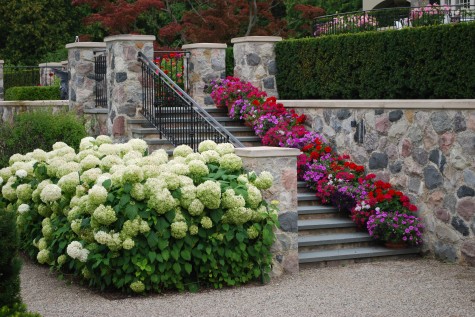 Mixing red with hot or magenta pink can add dimension, and sparkle, when the intent is to wow with red. The white of these Annabelle hydrangeas doesn’t hurt; the color all around seems lively.
Mixing red with hot or magenta pink can add dimension, and sparkle, when the intent is to wow with red. The white of these Annabelle hydrangeas doesn’t hurt; the color all around seems lively.  Intense or dark colors read best up close. To me, every composition has a foreground, a mid ground-and the background. These red geraniums are fiery, up close to the eye. The red dahlias in this mid ground-they seem much muted, even though they are the same red color as the geraniums. Lighting conditions and distance greatly influence the effect of color.
Intense or dark colors read best up close. To me, every composition has a foreground, a mid ground-and the background. These red geraniums are fiery, up close to the eye. The red dahlias in this mid ground-they seem much muted, even though they are the same red color as the geraniums. Lighting conditions and distance greatly influence the effect of color.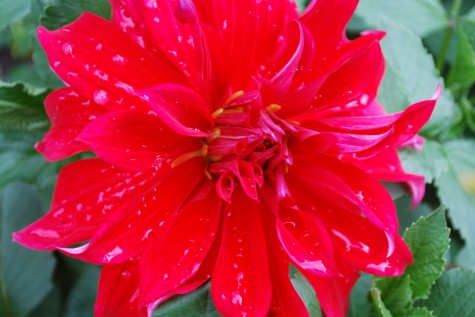 Dinner plate dahlias are something else-whether you love them or reach for your sunglasses, they are the most dramatic representation of red in the garden I can imagine. Were I interested in taking that red as red as I might manage, I would tuck them in between plants in a stand of arundo donax variegata. Red and white-so striking.
Dinner plate dahlias are something else-whether you love them or reach for your sunglasses, they are the most dramatic representation of red in the garden I can imagine. Were I interested in taking that red as red as I might manage, I would tuck them in between plants in a stand of arundo donax variegata. Red and white-so striking.  Some of my clients turn their noses up and roll their eyes should I use the word geranium. I look at them at the little black dress of the annual world; they can be stunning, in an expected way-but nonetheless, stunning. What you pair with red geraniums makes all the difference in the world. Whether by way of contrast, or by way of intensifying that fiery color, the idea here is to be purposeful. Whatever effect is in your heart or mind’s eye, understanding how color works will help make your idea visual.
Some of my clients turn their noses up and roll their eyes should I use the word geranium. I look at them at the little black dress of the annual world; they can be stunning, in an expected way-but nonetheless, stunning. What you pair with red geraniums makes all the difference in the world. Whether by way of contrast, or by way of intensifying that fiery color, the idea here is to be purposeful. Whatever effect is in your heart or mind’s eye, understanding how color works will help make your idea visual. 